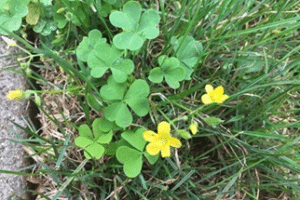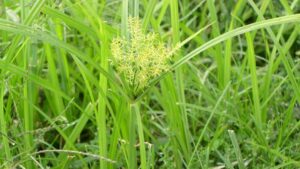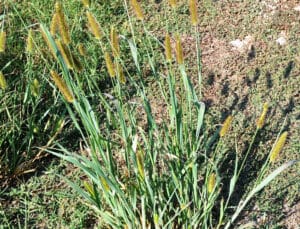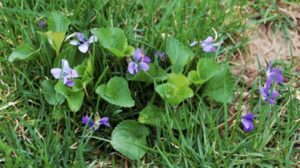Microstegium vimineum (Trin.
Description
Introduced from Asia in 1919 as packing material, this warm season grass species has spread throughout much of the eastern portion of the United States. Japanese stiltgrass thrives in moist soils and in areas with heavy to moderate shade. It can also persist in full sun, usually in disturbed areas with poor soils or rocky outcrops. This species is widely distributed in Pennsylvania and is becoming a significant problem in lawns in the southeastern portion of the commonwealth.
Japanese stiltgrass is an aggressive annual weed that spreads by seed and horizontal runners or stolons. Seed of Japanese stiltgrass is easily disseminated via mowing equipment, shoes, clothing, animal fur, and flooding. Homeowners and professional turf managers typically find its coarse texture and fast growth rate objectionable in stands of cool season turfgrass. Fortunately, Japanese stiltgrass is relatively easy to identify and can be controlled using good cultural practices and certain herbicides applied at the correct time of year and growth stage.
Life Cycle
Japanese stiltgrass is a member of the Poaceae family and has a summer annual life cycle. Seed of this species begins to germinate in late winter or early spring, a few weeks prior to crabgrass germination. Following germination and emergence plants make rapid vegetative growth during late spring and summer. Seedheads are produced from late summer to October and generate 100 to 1,000 seeds per plant. Japanese stiltgrass plants exhibit a reddish-purple color in early fall then turn brown and die following a succession of frosts in mid to late fall. Seeds produced in fall give rise to new plants the following spring given proper conditions for germination and emergence. Seeds can remain viable in soil for several years.
Identification
Japanese stiltgrass can be distinguished from other grass weeds by its broad, lance-shaped leaf blades and upright, spreading stems. It often resembles miniature bamboo plants. Leaf blades are usually pale green, about 1/2 inch wide and 2 to 4 inches in length, often with a silver stripe running lengthwise down the center and pointed or slightly rounded at tips. The backside of the collar (located at the junction of the leaf blade and sheath) is slightly hairy and the ligule is short and membranous. Leaves are arranged alternately on stems. Stems are long (up to 4 feet in length), thin, and branching. Initially upright, stems tend to lay over and form a dense mat. Another characteristic feature of Japanese stiltgrass is shallow rooting and aerial rootlets or “stilts” that initiate from nodes on stem bases and extend into the soil (hence the name “stiltgrass”). Inconspicuous seedheads are arranged on slender stalks and contain 1 to 3 seed-bearing spikes. Seeds are small (about 3.0 millimeters in length), elliptical, and often have twisted awns at tips. Japanese stiltgrass can be confused with other grass and broadleaf weeds with similar identification features, such as nimblewill, crabgrass, and Pennsylvania smartweed.
Cultural Control
Japanese stiltgrass is introduced into turf stands primarily through transfer of seed on maintenance equipment, shoes, animal fur, in soil used for renovation projects, and by other means. Although there is no practical way to detect seeds in soil, using soils from sites with no previous history of Japanese stiltgrass infestation can lessen the chances of contamination of turfgrass sites. If only a few Japanese stiltgrass plants are infesting a lawn, they can be removed by hand pulling soon after leaf emergence in spring and before seedheads form later in the growing season. Improving turf density through fertilization, removing trees or trimming branches to reduce shading, and use of turfgrasses well-adapted to site conditions will help slow the spread of Japanese stiltgrass but may not provide effective suppression once this weed is well established. If infestations occur in lawns, mow frequently to prevent seedheads from forming and producing seeds. If seedheads are observed in lawns during late summer and fall, bagging and removing mower clippings from the site may help to reduce further seed dispersal.
Chemical Control
Japanese stiltgrass can be controlled with certain preemergence herbicides if applications are properly timed. Since seed of this species begins to germinate before crabgrass, preemergence herbicides should be applied 2 to 3 weeks earlier than dates recommended for crabgrass control. Active ingredients that have shown consistent preemergence control of Japanese stiltgrass (86% control or greater) include prodiamine (Barricade and other prodiamine-containing products), pendimethalin (Pre-M, Pendulum, and other pendimethalin-containing products), and dithiopyr (Dimension and other dithiopyr-containing products) (Judge et al., 2005). As of this writing, dithiopyr products are the only preemergence herbicides labeled for Japanese stiltgrass control (listed on labels as Mary’s grass and Microstegium vimineum).
Selective postemergence herbicides are generally less effective in controlling Japanese stiltgrass when compared to preemergence herbicides, but some can provide greater than 50% control if applied to young plants up to the 3 to 4 tiller growth stage.
Fenoxaprop-p-ethyl (Acclaim Extra) and topramezone (Pylex) are the only postemergence herbicides labeled for control of Japanese stiltgrass in cool season turfgrasses. Be sure to follow label precautionary statements, restrictions, and directions regarding rates and timing of applications when using these herbicides. On infrequently mowed fine fescue rough areas on golf courses, sethoxydim (Segment II and Sethothydim SPC) and fluazifop-p-butyl (Fusilade II) can provide good control of Japanese stiltgrass when two applications are made at 4-week intervals to plants that are 6 to 7 inches in height (Judge et al., 2005). However, Japanese stiltgrass is not listed on the labels of these herbicides.





